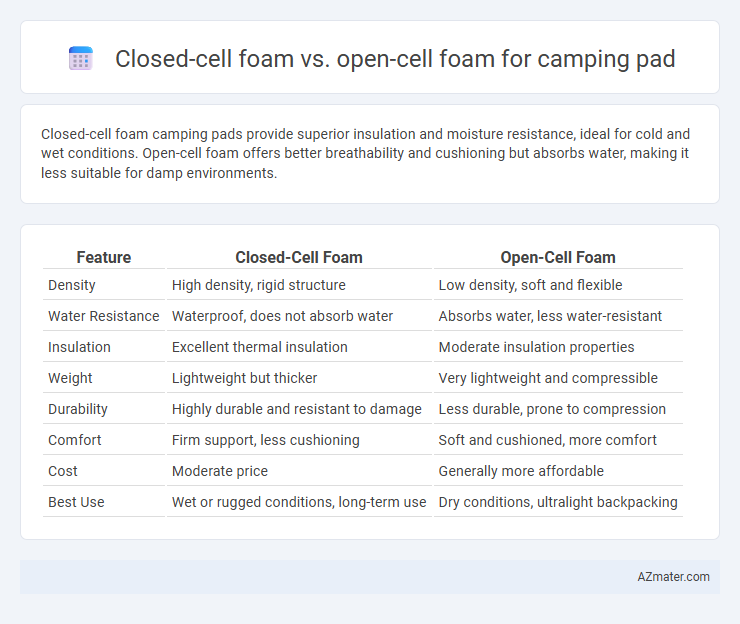Closed-cell foam camping pads provide superior insulation and moisture resistance, ideal for cold and wet conditions. Open-cell foam offers better breathability and cushioning but absorbs water, making it less suitable for damp environments.
Table of Comparison
| Feature | Closed-Cell Foam | Open-Cell Foam |
|---|---|---|
| Density | High density, rigid structure | Low density, soft and flexible |
| Water Resistance | Waterproof, does not absorb water | Absorbs water, less water-resistant |
| Insulation | Excellent thermal insulation | Moderate insulation properties |
| Weight | Lightweight but thicker | Very lightweight and compressible |
| Durability | Highly durable and resistant to damage | Less durable, prone to compression |
| Comfort | Firm support, less cushioning | Soft and cushioned, more comfort |
| Cost | Moderate price | Generally more affordable |
| Best Use | Wet or rugged conditions, long-term use | Dry conditions, ultralight backpacking |
Introduction to Foam Types in Camping Pads
Closed-cell foam camping pads feature a dense, rigid structure that provides superior insulation and durability, making them ideal for cold and rugged outdoor conditions. Open-cell foam pads are softer and more breathable, offering enhanced comfort and flexibility but less insulation against moisture and cold. Choosing the right foam type depends on the specific camping environment and the balance between comfort, weight, and thermal protection.
What is Closed-Cell Foam?
Closed-cell foam is a dense, rigid material characterized by tightly packed cells that trap air, providing superior insulation and water resistance in camping pads. This type of foam offers excellent durability and compressive strength, making it ideal for outdoor use where moisture and rough terrain are common. Its closed structure prevents water absorption, ensuring the pad remains lightweight and dry throughout camping trips.
What is Open-Cell Foam?
Open-cell foam is a lightweight, flexible material characterized by interconnected air pockets that allow for excellent breathability and cushioning, making it ideal for camping pads designed for comfort. It absorbs moisture more readily than closed-cell foam, which can affect insulation performance in damp conditions but enhances airflow and reduces weight. Open-cell foam pads are generally softer and compressible, offering superior comfort on uneven terrain compared to the more rigid, water-resistant closed-cell alternatives.
Insulation and R-Value Comparison
Closed-cell foam camping pads provide superior insulation with higher R-values, typically ranging from 3.5 to 5 per inch, making them ideal for cold-weather camping by effectively retaining body heat and blocking moisture. Open-cell foam pads have lower R-values, generally between 1 to 2 per inch, offering less thermal resistance but increased cushioning and breathability. The denser structure of closed-cell foam enhances durability and water resistance, while open-cell foam is lighter and more compressible, suitable for mild conditions.
Weight and Packability Differences
Closed-cell foam camping pads are significantly lighter and more compact than open-cell foam pads, making them ideal for backpackers prioritizing weight and packability. The closed-cell structure resists water absorption, maintaining a consistent weight even in damp conditions, while open-cell foam absorbs moisture and bulk, increasing overall weight and size. For ultralight camping setups, closed-cell foam offers superior portability without compromising insulation performance.
Comfort and Cushioning: Which Feels Better?
Closed-cell foam camping pads offer firmer, more supportive cushioning with higher density, providing excellent insulation and durability on uneven terrain. Open-cell foam pads deliver a softer, more cushioned feel that contours to the body, enhancing comfort but sacrificing some insulation and compressive strength. For campers prioritizing long-lasting support and warmth, closed-cell foam feels better, while open-cell foam suits those seeking plush comfort and lightweight padding.
Durability and Longevity
Closed-cell foam camping pads offer superior durability and longevity due to their dense, rigid structure that resists moisture, compression, and punctures, making them ideal for extended outdoor use. Open-cell foam pads, while lighter and more comfortable, tend to absorb water and compress over time, reducing their lifespan and durability in rugged conditions. For campers seeking a long-lasting, resilient sleeping surface, closed-cell foam provides a more reliable option.
Moisture Resistance and Water Absorption
Closed-cell foam excels in moisture resistance and features low water absorption, making it highly effective for camping pads in wet conditions. Open-cell foam absorbs water more readily due to its porous structure, which can compromise insulation and prolong drying times. Choosing closed-cell foam ensures better durability and comfort by preventing water retention and maintaining thermal performance during outdoor activities.
Price Range and Value for Money
Closed-cell foam camping pads typically range from $20 to $60, offering excellent durability, insulation, and water resistance, making them a cost-effective choice for budget-conscious campers. Open-cell foam pads, priced between $30 and $80, provide superior cushioning and comfort but are less water-resistant and less durable, which may reduce long-term value. Closed-cell foam delivers better value for money for those prioritizing longevity and weather resistance, while open-cell foam suits campers seeking enhanced comfort despite higher replacement costs.
Best Use Cases: Which Foam for Different Camping Styles
Closed-cell foam camping pads offer superior insulation and durability, making them ideal for cold-weather backpacking and winter camping where moisture resistance and thermal protection are critical. Open-cell foam pads provide lightweight comfort and excellent cushioning, best suited for warm-weather camping and car camping where weight is less of a concern. Selecting the right foam depends on balancing factors like temperature, terrain, and pack weight for optimal comfort and performance.

Infographic: Closed-cell foam vs Open-cell foam for Camping pad
 azmater.com
azmater.com